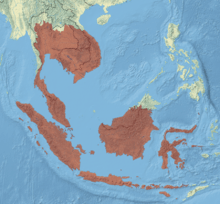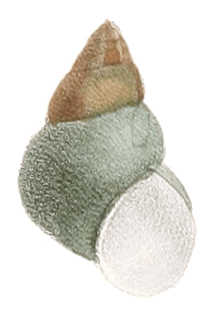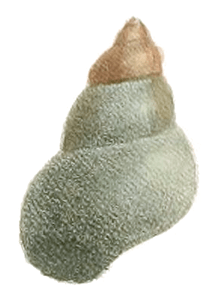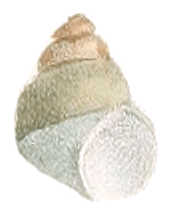Filopaludina javanica
| Filopaludina javanica | |
|---|---|
| Scientific classification | |
| Kingdom: | Animalia |
| Phylum: | Mollusca |
| Class: | Gastropoda |
| (unranked): | clade Caenogastropoda informal group Architaenioglossa |
| Superfamily: | Viviparoidea |
| Family: | Viviparidae |
| Genus: | Filopaludina |
| Subgenus: | Siamopaludina[2] |
| Species: | F. javanica |
| Binomial name | |
| Filopaludina javanica (von dem Busch, 1844)[3] | |
| Synonyms[1][4] | |
|
Vivipara javanica von dem Busch, 1844 | |
Filopaludina javanica or Idiopoma javanica[1] is a species of large freshwater snail with a gill and an operculum, an aquatic gastropod mollusk in the family Viviparidae.
Subspecies
There are recognized two subspecies:[1]
- Filopaludina javanica javanica (von dem Busch, 1844)
- Filopaludina javanica continentalis or Idiopoma javanica continentalis Brandt, 1974[1]

Distribution
This species is found in Thailand,[5] Cambodia, Vietnam, Laos, Peninsular Malaysia and Indonesia (Sumatra and Java).[1]
Description
The height of the shell is 30–35 mm.[6]
 Drawing of an apertural view of a shell of Filopaludina javanica from its type description. |
 An abapertural view. |
 A juvenile shell. |
Ecology
This species inhabits ponds, rice fields and irrigation channels.[1]
Parasites of Filopaludina javanica include Echinostoma echinatum[7][8] (see also Beaver et al. 1984).[9]
Human use
Filopaludina javanica is prepared by boiling and it used often as part of the cuisine of Java.[10]
References
- 1 2 3 4 5 6 7 Köhler F., Sri-aroon P. & Simonis J. (2012). "Idiopoma javanica". The IUCN Red List of Threatened Species. Version 2014.2. <www.iucnredlist.org>. Downloaded on 04 September 2014.
- ↑ (Indonesian) Marwoto R. M. & Nurinsiyah A. S. (2009). "Keanekaragaman keong air tawar marga Filopaludina di Indonesia dan status taksonominya (Gastropoda: Viviparidae)". Prosiding Seminar Nasional Moluska 2: “Moluska: Peluang Bisnis dan Konservasi”. Bogor, 11-12 Februari 2009. Hal. II, 202-213. PDF.
- ↑ (German) Philippi R. A. (1845) Abbildungen und Beschreibungen neuer oder wenig gekannter Conchylien. (3): page 114-115, table 1, figure 11-12.
- ↑ Marwoto R. M. & Nurinsiyah A. S. (2009)?. "A PRELIMINARY STUDY OF FRESHWATER SNAIL VIVIPARIDAE IN INDONESIA: STUDY ON MORPHOLOGY OF THE GENUS FILOPALUDINA HABE, 1964 (MOLLUSCA: GASTROPODA, VIVIPARIDAE)". Poster. PDF.
- ↑ Kittivorachate R. & Yangyuen C. (2004). "Molluscs in the Ubolratana Reservoir, Khon Kaen". Kasetsart Journal (Nat. Sci.) 38: 131-139. PDF.
- ↑ (German) Kobelt W. (1909). "Die Gattung Paludina Lam. (Vivipara Montfort) (Neue Folge). In Abbildungen nach der Natur mit Beschreibungen". Systematisches Conchylien-Cabinet von Martini und Chemnitz, Nürnberg, 1(21a): pp. 97-430, plates 15-77. page 251-, table 5, fig. 7-10. table 52, fig. 1-7.
- ↑ Fried B. & Toledo R. (2009). The Biology of Echinostomes: From the Molecule to the Community. Springer Science & Business Media, 344 pp., page 162.
- ↑ Murrell K. D. & Fried B. (2007). Food-Borne Parasitic Zoonoses: Fish and Plant-Borne Parasites. Springer Science & Business Media, 442 pp., page 59.
- ↑ Beaver P. C., Jung R. C. & Cupp E. W. (1984). Clinical Parasitology 9th Edition. Lea & Febiger, Philadelphia.
- ↑ Sulianti A. (2008). "Cooking Echinostoma-infected Bellamya javanica for safe consumption". Proceedings of the Third ASEAN Congress of Tropical Medicine and Parasitology (ACTMP3). The Windsor Suites Hotel, Bangkok, Thailand, 22–23 May 2008. Parasites: a hidden threat to global health 2009 pp. 28-32. abstract.
External links
| Wikimedia Commons has media related to Filopaludina javanica. |
- van Benthem Jutting W. S. S. (1956). "Systematic Studies On The Non-Marine Mollusca Of The Indo-Australian Archipelago. Critical Revision of The Javanese Freshwater Gastropods". Treubia 23(2): 259-477.
- (German) Küster H. C. (1852). "Die Gattungen Paludina, Hydrocaena und Valvata in Abbildungen nach dem Natur". Systematisches Conchylien-cabinet von Martini und Chemnitz fortgesetzt von Hofrath Dr. G. H. v. Schubert und Professor J. A. Wagner. Verlag von Bauer und Raspe, Nürnberk. 96 pp. 24-25, tab. 5, fig. 7-10.
